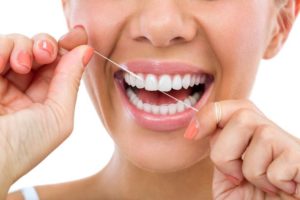 Flossing is just as important to healthy teeth and gums as seeing your family dentist in Massapequa for cleanings and exams. Unfortunately, all too many of us fail to perform this important daily task. In this post we’ll explain why flossing is a vital key to your oral health. We’ll also discuss flossing tips and floss alternatives like water-stream flossers and interdental toothbrushes.
Flossing is just as important to healthy teeth and gums as seeing your family dentist in Massapequa for cleanings and exams. Unfortunately, all too many of us fail to perform this important daily task. In this post we’ll explain why flossing is a vital key to your oral health. We’ll also discuss flossing tips and floss alternatives like water-stream flossers and interdental toothbrushes.
Why Flossing is Essential
Almost everyone understands the importance of brushing, thanks to dentists, concerned parents, and public service announcements. When we brush, we remove plaque and food particles that otherwise can build up and promote the spread of cavity-causing bacteria. Experts recommend that we brush at least twice a day, although after every meal is better.
Unfortunately, brushing by itself can never remove all of the food particles and plaque stains that cause dental problems. That’s where flossing comes into the picture. Along with professional cleanings from your dentist, it keeps these problems under control, enabling us to enjoy healthier teeth and gums. When we neglect flossing, we give cavities the upper hand; it’s as simple as that.
Is It Just about Food Particles?
Some people neglect to floss because they believe its only purpose is to remove food particles between their teeth. In reality, flossing also removes plaque that brushing alone may miss. Left in place, these plaque deposits will eventually harden into tartar, which not only leads to cavities but stains and discoloration as well. This is why both practices are important for enjoying healthy teeth and gums.
Three Tips for Effective Flossing
Good flossing technique is essential for enjoying the most benefits from the habit. Here are three tips to guide you:
- Hold the string firmly between your fingers and move it in both an up-and-down and back-and-forth motion. Wrap the string around the front and back of each tooth rather than simply focusing on the areas between teeth.
- Take your time. Most of us floss too quickly. It’s important to floss every day; after each meal is better.
- Try different brands. Floss strings come in various widths and filament designs to match a range of oral profiles. Some people prefer floss with wax coatings, others without. Try several different types to choose the right one for you.
People with certain health conditions, such as arthritis, may find floss string difficult to hold. These people may want to try an interdental toothbrush or a water-stream flosser, both of which offer benefits similar to traditional floss.
When Should Children Begin Flossing?
Flossing requires a certain degree of manual dexterity that younger children may not yet possess. Still, it’s important to get them accustomed to using floss. You may want to begin by helping your children until they are able to take over the task themselves, which usually occurs around age two.
Your dentist in Massapequa can offer additional tips for getting the most benefit from flossing. Discuss this important topic with him or her during your next appointment. That’s a great way to lay the foundation for a lifetime of healthy teeth and gums.
About the Author
Dr. Khalida Stutman has been practicing dentistry for over 25 years. She earned her DDS degree from Case Western Reserve University School of Graduate Dentistry and is a member of the American Academy of Cosmetic Dentistry. You can reach her office online or by calling (516) 798-3808.
